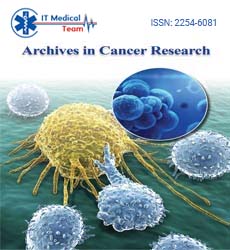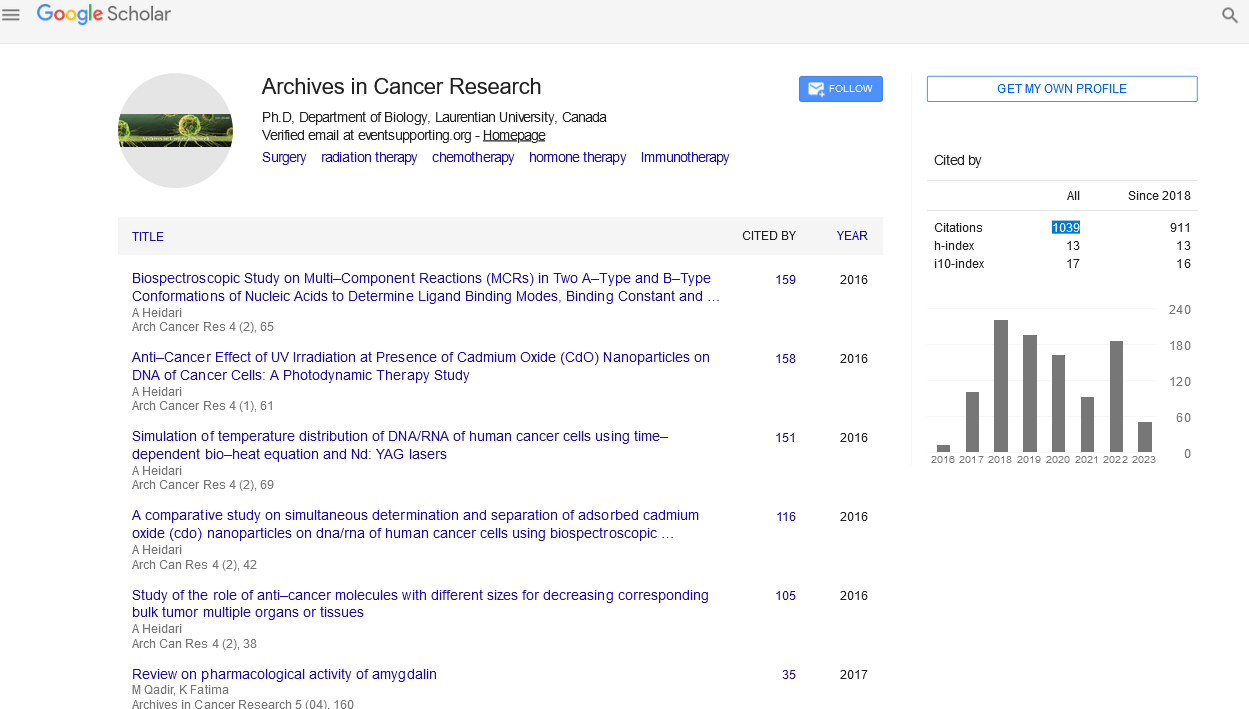Perspective - (2024) Volume 12, Issue 5
Neuroblastoma: Understanding the Disease, Advances in Treatment, and Future Directions
Mani Kandhan*
Department of Population Health, University of Oxford, United Kingdom
*Correspondence:
Mani Kandhan, Department of Population Health, University of Oxford,
United Kingdom,
Email:
Received: 12-Sep-2024, Manuscript No. IPACR-24-15010;
Editor assigned: 17-Sep-2024, Pre QC No. IPACR-24-15010 (PQ);
Reviewed: 01-Oct-2024, QC No. IPACR-24-15010;
Revised: 11-Oct-2024, Manuscript No. IPACR-24-15010 (R);
Published:
18-Oct-2024
Introduction
Neuroblastoma is a rare but serious childhood cancer that
arises from immature nerve cells, most commonly found in the
adrenal glands or along the spine. It is the most common extra
cranial solid tumor in children, typically diagnosed before the
age of five. Neuroblastoma varies widely in its clinical
presentation and prognosis, making it a complex disease to
manage. This article explores the biology of neuroblastoma,
current treatment approaches, recent advancements in
research, challenges in managing the disease, and promising
future directions in neuroblastoma therapy.
Description
Understanding neuroblastoma
Biological basis: Neuroblastoma originates from neural crest
cells, which are precursors to nerve cells and adrenal glands during
embryonic development. Genetic mutations and alterations in
these cells lead to uncontrolled growth and proliferation, resulting
in the formation of tumors. The disease can manifest in various
locations, including the adrenal glands, abdomen, chest, and neck.
Clinical presentation: Neuroblastoma presents with diverse
clinical features depending on tumor location, stage, and age at
diagnosis. Symptoms may include abdominal distension, bone
pain, fever, and neurological deficits. The International
Neuroblastoma Staging System (INSS) categorizes neuroblastoma
into stages based on tumor size, spread to lymph nodes, and
distant metastasis, guiding treatment decisions and prognosis.
Current treatment approaches
Risk stratification and treatment planning: Risk stratification is
crucial in determining the appropriate treatment approach for
neuroblastoma patients. Low-risk neuroblastomas, often detected
at an early stage with favorable biological characteristics, may
undergo observation or minimal intervention. Intermediate and
high-risk neuroblastomas require multimodal therapy, including
surgery, chemotherapy, radiation therapy, and immunotherapy,
tailored to individual patient risk factors.
Surgery: Surgical resection of the primary tumor and adjacent
lymph nodes is often the initial step in managing neuroblastoma.
Complete surgical resection can improve outcomes, especially in
low-risk and localized disease. However, the extent of surgical
intervention may be limited in cases where tumors are
inoperable or involve critical structures.
Chemotherapy: Chemotherapy plays a central role in the
treatment of intermediate and high-risk neuroblastoma.
Chemotherapeutic agents, such as cisplatin, doxorubicin,
etoposide, and cyclophosphamide, target rapidly dividing cancer
cells and aim to shrink tumors before surgery or radiation
therapy. Chemotherapy regimens are intensively tailored based
on risk group and response to initial treatment phases.
Radiation therapy: Radiation therapy may be used to target
residual tumors or metastatic sites after surgery or chemotherapy.
It delivers high-energy radiation to cancer cells, damaging their
DNA and inhibiting growth. Advances in radiation techniques, such
as Intensity-Modulated Radiation Therapy (IMRT) and proton
therapy, allow for more precise tumor targeting while sparing
healthy surrounding tissues.
Immunotherapy and targeted therapies: Immunotherapy has
emerged as a promising treatment strategy for neuroblastoma,
particularly in high-risk cases. Monoclonal antibodies, such as
dinutuximab, target specific antigens on neuroblastoma cells,
enhancing immune-mediated tumor cell killing. Targeted
therapies, including tyrosine kinase inhibitors and anti-GD2
therapies, disrupt signaling pathways critical for cancer cell
survival and proliferation.
Advancements in neuroblastoma research
Genomic profiling and molecular subtyping: Recent
advancements in genomic profiling have identified key genetic
alterations and molecular subtypes of neuroblastoma. High-risk
genetic mutations, such as amplification of the MYCN oncogene
or deletions in chromosome 1p and 11q, correlate with
aggressive disease and poor prognosis. Molecular subtyping
enables personalized treatment approaches and facilitates the
development of targeted therapies.
Immunotherapy innovations: Immunotherapy continues to
evolve with the development of novel immune checkpoint
inhibitors and Chimeric Antigen Receptor (CAR) T-cell therapies
for neuroblastoma. These therapies enhance immune system
recognition and targeting of neuroblastoma cells, offering new
avenues for treating refractory or relapsed disease.
Stem cell transplants: High-dose chemotherapy followed by
autologous Hematopoietic Stem Cell Transplantation (HSCT) is
used in select cases of high-risk neuroblastoma to improve
treatment outcomes. HSCT allows for dose escalation of
chemotherapy while preserving hematopoietic function through
stem cell rescue. Ongoing research focuses on optimizing
conditioning regimens and reducing treatment-related
complications.
Tumor microenvironment and therapeutic resistance: The
tumor microenvironment plays a critical role in neuroblastoma
progression and treatment response. Stromal cells, immune
cells, and extracellular matrix components interact with
neuroblastoma cells, influencing tumor growth, invasion, and
therapeutic resistance. Targeting the tumor microenvironment
represents a novel therapeutic strategy to enhance treatment
efficacy and overcome drug resistance mechanisms.
Challenges in neuroblastoma management
High relapse rates: Despite aggressive multimodal therapies,
high-risk neuroblastoma is associated with significant relapse
rates and treatment failures. Tumor heterogeneity, metastatic
spread, and molecular resistance mechanisms contribute to
treatment resistance and disease recurrence. Strategies to
prevent relapse and improve long-term survival remain a
primary focus of research.
Long-term side effects: Intensive treatment regimens,
including chemotherapy and radiation therapy, can result in
long-term adverse effects, such as cardiotoxicity, neurocognitive
deficits, endocrine dysfunction, and secondary malignancies.
Longitudinal survivorship care programs are essential to monitor
and manage late effects, optimize quality of life, and support
neuroblastoma survivors and their families.
Limited treatment options for relapsed disease: Relapsed or
refractory neuroblastoma poses significant therapeutic challenges
due to acquired resistance to standard treatments and limited
salvage therapies. Clinical trials evaluating novel agents,
combination therapies, and immune-based approaches offer
hope for improving outcomes in relapsed disease settings.
Future directions in neuroblastoma therapy
Precision medicine and personalized therapeutics: Advances
in genomic sequencing and molecular profiling will drive the
development of personalized treatment strategies for
neuroblastoma. Precision medicine approaches aim to match
patients with targeted therapies based on specific genetic
mutations, biomarkers, and tumor characteristics, optimizing
treatment efficacy and minimizing toxicity.
Innovative immunotherapies: Continued research into immune
checkpoint inhibitors, CAR T-cell therapies, and bispecific
antibodies holds promise for expanding immunotherapy options in
neuroblastoma. Combination approaches that enhance immune
activation and overcome immunosuppressive signals within the
tumor microenvironment are under investigation to improve
response rates and durable remissions.
Biomarker discovery and early detection: Biomarker
discovery efforts seek to identify novel diagnostic biomarkers
and predictive markers of treatment response in neuroblastoma.
Early detection strategies using liquid biopsies, circulating tumor
DNA (ctDNA), and imaging modalities aim to detect minimal
residual disease and monitor treatment efficacy, facilitating
timely intervention and improved outcomes.
Global collaborations and clinical trials: Collaborative
research initiatives and international consortia play a vital role in
advancing neuroblastoma research and clinical trials. Multiinstitutional
collaborations enable data sharing, standardization
of treatment protocols, and enrollment of patients in innovative
therapies. Global efforts to expand access to experimental
treatments and novel therapies will accelerate progress toward
improving survival rates and quality of life for neuroblastoma
patients worldwide.
Conclusion
Neuroblastoma remains a challenging pediatric cancer
characterized by its clinical heterogeneity and variable
outcomes. Advances in understanding the disease biology, risk
stratification, and treatment modalities have transformed
outcomes for many patients. Ongoing research efforts continue
to unravel the molecular underpinnings of neuroblastoma,
identify novel therapeutic targets, and develop innovative
treatment strategies. Future directions in precision medicine,
immunotherapy, and biomarker-driven therapies hold promise
for further improving survival rates, reducing treatment-related
toxicities, and enhancing long-term quality of life for children
diagnosed with neuroblastoma.
Citation: Kandhan M (2024) Neuroblastoma: Understanding the Disease, Advances in Treatment and Future Directions. Archives Can Res
Vol:12 No:5





